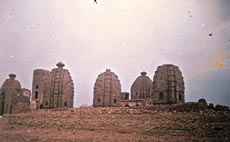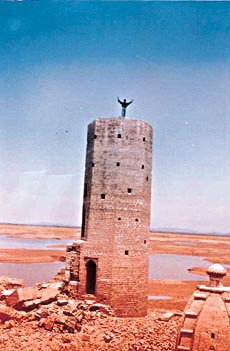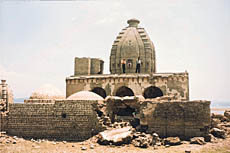A neglected
heritage!
By D. C.
Sharma
THREE kilometres east of Dhameta,
a small town in Kangra, there stands a cluster of
antique, unique, tall temples which remain dipped in
water for nine months but stand exposed to the human eye
only during April, May and June. While these three months
attract pilgrims to these temples, the other nine months
attract tourists, fishermen and multitudes of a variety
of unique colourful birds migrated from islands of
various continents of the world. Throughout the year,
this place, commonly known as "Bathu ki Larhi"
(a string of Bathu stone-structures) enjoys the unique
distinction of being a popular tourist spot.
 Before 1974, this cluster of
unique artistic temples would attract pilgrims from all
over the country, throughout the year. Then there was
only the flowing Beas water near them, and no dam water
engulfed them as it does today. It was in 1961 that the
work of Pong Dam was started, giving it the final shape
in 1970. This dam, which now occupies the vast stretch of
land falling within the boundaries of Terris, Dhameta,
Bharmad, Jwali, Nagrota Suriyan, Dada-Sibha and Dehra,
was filled with rain water in 1974, carrying waters of
the Beas, and those of the rivulets of Gajj, Vool and
Bundeir. This water level (1410 feet) uprooted a large
number of inhabitants, green flourishing trees were got
cut, crops were done away with as the dam was filled with
tonnes of rain water. Before 1974, this cluster of
unique artistic temples would attract pilgrims from all
over the country, throughout the year. Then there was
only the flowing Beas water near them, and no dam water
engulfed them as it does today. It was in 1961 that the
work of Pong Dam was started, giving it the final shape
in 1970. This dam, which now occupies the vast stretch of
land falling within the boundaries of Terris, Dhameta,
Bharmad, Jwali, Nagrota Suriyan, Dada-Sibha and Dehra,
was filled with rain water in 1974, carrying waters of
the Beas, and those of the rivulets of Gajj, Vool and
Bundeir. This water level (1410 feet) uprooted a large
number of inhabitants, green flourishing trees were got
cut, crops were done away with as the dam was filled with
tonnes of rain water.
Bathu ki Larhi is a
cluster of eight temples covering a vast area which used
to have strong protection walls which are now falling and
crumbling in the strong current of waters.
In spite of the fact
that for the last 25 years this cluster of temples
remains dipped in water for nine months every year, yet
their stone structure has the same natural colour, beauty
and lusture as it used to have when they were actually
constructed. Such is the durability of Bathu stone, a
quality preferred in the entire Himachal. Only the colour
of plaster and those of the bricks has undergone a
change.
 It is
said that this cluster of temples was made by the
Pandavas during one night when it used to be of six
months long. The legend reveals how the Pandavas could
have completed their ladder to Swarg-Dwar
(Heaven), had the day break been a bit late. They had to
suspend their work at the break of day, and the lime
mixture they had prepared for use is still lying on the
roof of a pyramid. It is
said that this cluster of temples was made by the
Pandavas during one night when it used to be of six
months long. The legend reveals how the Pandavas could
have completed their ladder to Swarg-Dwar
(Heaven), had the day break been a bit late. They had to
suspend their work at the break of day, and the lime
mixture they had prepared for use is still lying on the
roof of a pyramid.
Another version goes
that these temples were made 500 years ago during the
reign of the Mougals. But since the stone idols (taken
out of these temples to Kandrori village) are of Hindu
gods and goddesses, there is every probability that they
were the creations pertaining to the Mahabharta era.
One has to cross the
main gate to enter this cluster of temples. The stone
images set on both sides of this gate, one image being of
Mother Kali and the other of Lord Ganesha, is an evidence
of the fact that the temples were built by the Pandavas
who were mainly the worshippers of Kali and Ganesha.
Before one enters the temple complex, one has to pass
through another main gate, all of which indicate how this
cluster of temples was covered with two protection walls
in order to save them from foreign invaders. There are
also protection walls and protection towers, now in
crumpled shape, but show how those days’ defence
system was par excellence.
 The broken images of Lord Vishnu
and Sheshnag, the antique artistic ladders with images of
Hindu gods inside the temple domes, amply prove how the
Hindu architecture was simply at its peak. The chisel and
stone work on Bathu stone is superb. The broken images of Lord Vishnu
and Sheshnag, the antique artistic ladders with images of
Hindu gods inside the temple domes, amply prove how the
Hindu architecture was simply at its peak. The chisel and
stone work on Bathu stone is superb.
Fifty kilometres east of
these temples stands another cluster of 15 rock-cut
temples of Masrur made by the Pandavas in the 8th
century. Further east of these rock-cut temples stand the
ruined antique forts of Guler and Kangra made well before
the great war of Mahabharata. Since all these four
spots are in somewhat straight line, it is an indication
how the Pandavas had built their safe defence spots to
save their country from the foreign invaders.
The Masrur temples are
now under survey and research. The Kangra fort has now
been improved like the Golconda fort. The Guler fort is
under consideration. But what about this Bathu ki Larhi?
This cluster of antique unique temples would be exposed
to the human eye in April, May and June 2000. The
authorities have eight months to plan and finalise the
steps for this most profitable archaeological research
which would certainly enrich our knowledge about our rich
Indian heritage.
|

